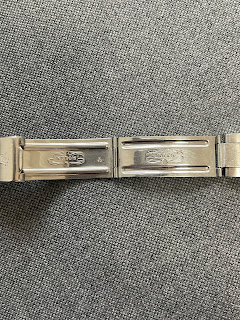Over the years, I have collected various vintage Rolex Sports models ranging from Rolex Daytona, Submariner, Explorer & GMT, with GMT being the weakest in term of the size of collection. As such, as a project, I have decided to improve my Rolex GMT collection. In addition, as I have be passing my watches to Keith, I shall need to finetune my collection to those that he may like..
Key Timeline & Series of Rolex GMT :
1954-1959: Ref. 6542:
The original GMT-Master, a 38mm watch with a Bakelite bezel (later replaced with aluminum) and a fourth hand for tracking a second time zone. Key characteristics is without the crown guard and small arrow.
1959-1980: Ref. 1675:
The first GMT-Master to feature crown guards and an increased case size to 40mm, becoming a collector's favorite. It has variations in term of the dial design as well as the different crown guards. It has both the early gilt dial and the later matte dials versions.
1981-1988: Ref. 16750, 16753, 16758:
Introduced the quick-set date function, a significant advancement in the GMT-Master's features. There are two kind of dials and two kinds of bezel.
1988-1998: Ref. 16700/16710:
Featured a sapphire crystal, a more modern design, and the automatic Rolex caliber 3175 movement.
1982-Present: GMT-Master II:
Introduced with independent hour hand adjustment, offering more flexibility in time zone tracking.
1989-2007: Ref. 16710:
A popular GMT-Master II iteration, known for its evolution through various dial and bezel color combinations.
2007-Present: GMT-Master II (New Generation):
Features advancements in movement technology and materials.
Initially, I was looking for the Rolex ref 16750. The Rolex GMT-Master 16750 is a vintage watch that was produced from the late 1970s to the late 1980s. The Rolex 16750 superseded the Ref. 1675 in the early 80's and along with it came some significant advancements. While the physical watch itself looks nearly identical, the new Ref. 16750 came with an upgraded higher beat movement and the addition of a quick-set date. Another benefit of the GMT-Master ref. 16750 is its water resistance – 330 feet (100 meters), which is double to that of previous GMT-Master models.
During its eight years of production, the Rolex GMT-Master ref. 16750 had two distinct dial variations within its steel case. The first generation had matte black dials with hour markers without white gold surrounds, while the later ones had glossy black dials with indexes that included the white gold surrounds. The two bezel choices of the stainless steel GMT-Master ref. 16750 were the iconic bi-color red and blue Rolex Pepsi bezel, in addition to the black bezel option.
However, after much consideration and by change, I have decided to go for the real vintage Rolex 1675 mk2 dial, Serial nos 3386xxx, year 1972 Bracelet 7836 End link 258, imprint 270, which was available for direct trade.
One of the more complex and interesting aspects of the Rolex 1675 is the dial variations. These dials are categorized within two genres: “gilt / glossy" and “matte”. Rolex produced gilt dials for their entire line of watches until circa 1966.
This is a 1972, mk2 dial.
The previous owner has bought this Rolex GMT mk2 from a vintage watch shop in HK
Comparison of the New vs old black bezel
For Rolex 1675 mk 2, dial, the coronet is very similar to that of the Type C & Mark 0 dials and the ‘Rolex’ printing is thick and the letters are more square than other matte dials, the majority of which are much wider than they are tall. The L and E in ‘Rolex’ are spaced much closer to each other than the rest of the letters. The lume is flat and does not appear as waffled as the late Mark 1 dials.
For the case top position has "REGISTERED DESIGN" on the first line and "1675" on the second line. The bottom position always has "STAINLESS STEEL" on the first line and the serial number on the second line.
From 1965 until the end of the 1675's production in 1980, the Caliber 1575 became the standard movement. This movement is often referenced as "Caliber 1570" in collector circles due to its base designation, though technically it is a 1575 when GMT-equipped .Movements from this era were engraved [1570] on the automatic winding bridge, reinforcing the "Caliber 1570" terminology among collectors despite the GMT module .
For the date disc, it has a flat 3 and open 6 & 9.
For detail, please read the following :


















No comments:
Post a Comment